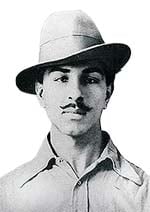
Bhagat Singh was considered to be one of the most famous revolutionaries of the Bharatiya Independence movement. For this reason, he is often referred to as ‘Shaheed’ (martyr) Bhagat Singh. At such a young age, if anyone was smiling just before being hanged to death, it was Martyr Bhagat Singh. His uncle, Sardar Ajit Singh, as well as his father, were great freedom fighters, so he grew up in a patriotic atmosphere. At an early age, he started dreaming of uprooting the British empire. Never afraid of fighting during his childhood, he thought of ‘growing guns in the fields’, so that he could fight the British. The Ghadar Movement left a deep imprint on his mind. Kartar Singh Sarabha, hanged at the age of 19, became his hero. The massacre at Jallianwala Bagh on 13th April, 1919 drove him to Amritsar, where he kissed the earth sanctified by the martyrs’ blood and brought back home a little of the soaked soil. At the age of 16, he used to wonder why so many Bharatiyas could not drive away a fistful of invaders.
Born: 28th Sept. 1907, Punjab
Died: Hanged in the early hours of 23rd March 1931.
In search of revolutionary groups and ideas, he met Sukhdev and Rajguru. Bhagat Singh, along with the help of Chandrashekhar Azad, formed the Hindustan Socialist Republican Army (HSRA). The aim of this Bharatiya revolutionary movement was now defined as not only to make Bharat independent, but also to create a socialist Bharat.
A brutal attack by the police on veteran freedom fighter Lala Lajpat Rai at an anti-British procession caused his death on 17th November 1928, in Lahore. Bhagat Singh determined to avenge Lajpat Rai’s death by shooting the British official responsible for the killing, Deputy Inspector General Scott. He shot down Assistant Superintendent Saunders instead, mistaking him for Scott.
Then he made a dramatic escape from Lahore to Calcutta and from there to Agra, where he established a bomb factory. The British Government responded to the act by imposing severe measures like the Trades Disputes Bill. It was to protest against the passing of the Bill that he threw bombs in the Central Assembly Hall (now our Loksabha) while the Assembly was in session. The bombs did not hurt anyone, but the noise they made was loud enough to wake up an enslaved Nation from a long sleep. After throwing the bombs, Bhagat Singh and his friend deliberately courted arrest by refusing to run away from the scene. During his trial, Bhagat Singh refused to employ any Defense counsel.
|
Rare photograph of Martyr Bhagat Singh (Courtsey : Mr. Sita Ram Bansal) |
Despite great popular pressure and numerous appeals by political leaders of Bharat, Bhagat Singh, Sukhdev and Rajguru were awarded the death sentence and hanged in the early hours of 23rd March 1931. Their bodies were cremated on the bank of the Sutlej in Ferozepur. Bhagat Singh was just 23 years old at that time. Old timers say that in many places, not a single hearth fire burned that day.
The last paragraph of the leaflet that he distributed (and wrote) in the Assembly Hall said: “We are sorry that we who attach such great sanctity to human life, we who dream of a very glorious future when man will be enjoying perfect peace and full liberty, have been forced to shed human blood. But sacrifice of individuals at the altar of the Revolution will bring freedom to all, rendering exploitation of man by man impossible. Inquilab Zindabad (Long live the Revolution).” There was a time when the very mention of the name of the young revolutionary stirred the passions of most Bharatiyas.


